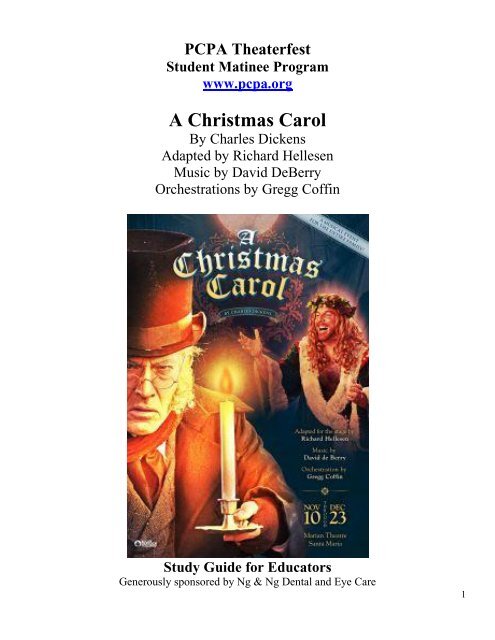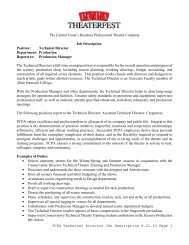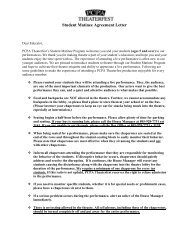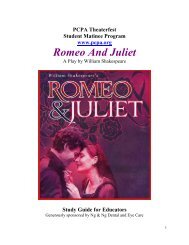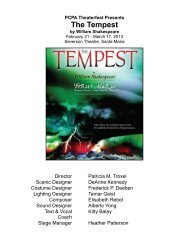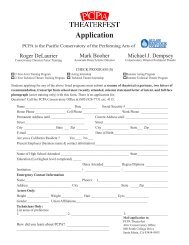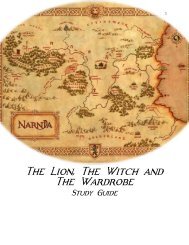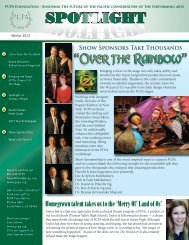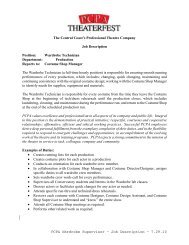A Christmas Carol - PCPA Theaterfest
A Christmas Carol - PCPA Theaterfest
A Christmas Carol - PCPA Theaterfest
Create successful ePaper yourself
Turn your PDF publications into a flip-book with our unique Google optimized e-Paper software.
<strong>PCPA</strong> <strong>Theaterfest</strong><br />
Student Matinee Program<br />
www.pcpa.org<br />
A <strong>Christmas</strong> <strong>Carol</strong><br />
By Charles Dickens<br />
Adapted by Richard Hellesen<br />
Music by David DeBerry<br />
Orchestrations by Gregg Coffin<br />
Study Guide for Educators<br />
Generously sponsored by Ng & Ng Dental and Eye Care<br />
1
Welcome to <strong>PCPA</strong> <strong>Theaterfest</strong><br />
A NOTE TO THE TEACHER<br />
Thank you for bringing your students to <strong>PCPA</strong> <strong>Theaterfest</strong> at Allan Hancock College. Here are some helpful<br />
hints for your visit to the Marian Theatre. The top priority of our staff is to provide an enjoyable day of live<br />
theatre for you and your students. We offer you this study guide as a tool to prepare your students prior to the<br />
performance.<br />
SUGGESTIONS FOR STUDENT ETIQUETTE<br />
Note-able behavior is a vital part of theater for youth. Going to the theater is not a casual event. It is a special<br />
occasion. If students are prepared properly, it will be a memorable, educational experience they will remember<br />
for years.<br />
1. Have students enter the theater in a single file. Chaperones should be one adult for every ten students. Our<br />
ushers will assist you with locating your seats. Please wait until the usher has seated your party before any<br />
rearranging of seats to avoid injury and confusion. While seated, teachers should space themselves so they are<br />
visible, between every groups of ten students. Teachers and adults must remain with their group during the<br />
entire performance.<br />
2. Once seated in the theater, students may go to the bathroom in small groups and with the teacher's<br />
permission. Please chaperone younger students. Once the show is over, please remain seated until the House<br />
Manager dismisses your school.<br />
3. Please remind your students that we do not permit:<br />
- food, gum, drinks, smoking, hats, backpacks or large purses<br />
- disruptive talking.<br />
- disorderly and inappropriate behavior (stepping on/over seats, throwing objects, etc.)<br />
- cameras, iPods, cell phones, beepers, tape recorders, hand held video games. (Adults are asked to put any<br />
beepers or cell phones on silent or vibrate.) In cases of disorderly behavior, groups may be asked to leave the<br />
theater without ticket refunds.<br />
4. Teachers should take time to remind students before attending the show of the following about a live<br />
performance: sometimes we forget when we come into a theatre that we are one of the most important parts of<br />
the production. Without an audience, there would be no performance. Your contribution of laughter, quiet<br />
attention and applause is part of the play.<br />
When we watch movies or television, we are watching images on a screen and what we say or do cannot affect<br />
them. In the theatre the actors are real people who are present and creating an experience with us at that very<br />
moment. They see and hear us and are sensitive to our response. They know how we feel about the play by how<br />
we watch and listen. An invisible bond is formed between actors and a good audience, and it enables the actors<br />
to do their best for you. A good audience helps make a good performance.<br />
<strong>PCPA</strong> <strong>Theaterfest</strong> welcomes you as a partner in the live theatre experience from the moment you take your<br />
seats. We hope that your visit will be a highlight of your school year.<br />
2
A <strong>Christmas</strong> <strong>Carol</strong> Cast and Production Team<br />
Director<br />
Choreographer<br />
Musical Director<br />
Scenic Designer<br />
Costume Designer<br />
Lighting Designer<br />
Sound Designer<br />
Vocal/ Dialect Coach<br />
Stage Manager<br />
Stage Manager<br />
Mark Booher<br />
Michael Jenkinson<br />
Callum Morris<br />
DeAnne Kennedy<br />
Frederick P. Deeben<br />
Jen 'Z' Zornow<br />
Elisabeth Rebel<br />
Andrew Philpot Production<br />
Christine Collins*<br />
Aleah Van Woert<br />
Cast of Characters<br />
Scrooge Peter S. Hadres*<br />
Bob Cratchit/Ensemble<br />
Evans Eden Jarnefeldt<br />
Fred/Italian Teacher/Young Ebeneezer<br />
Michael Jenkinson*<br />
Labourer/Parent/Clerk/Topper Quinn Mattfeld*<br />
Tailor/Parent Scott Fuss<br />
Subscription Gent/<br />
Ghost of <strong>Christmas</strong> Present Erik Stein*<br />
Grocer/Marley/Fezziwig/<br />
Belle's Husband/Old joe<br />
Andrew Philpot*<br />
Subscription Gent/Beer Seller/Guest Paul Henry<br />
Niece/Parent/Mrs. Fezziwig/Laundress Karen Hendricks<br />
Tailior's Wife/Parent/<br />
Baker's Wife/Female Guest Anne Guynn<br />
Martha Cratchit/Mrss Fezziwig Chrissi Erickson<br />
Mrs. Cratchit/Parent/Matron Belle Elizabeth Stuart<br />
Charwoman/Ghost of <strong>Christmas</strong> Past Kitty Balay*<br />
Sister-in-Law/Maid/Mess Fezziwig Andrea Hilbrant<br />
Peter Cratchit/Schoolboy/<br />
Apprentice Ebeneezer Zachary Bukarev-Padlo<br />
Labourer/Suitor/Yet to Come Mackenszie Drae<br />
Labourer/Suitor/Wreath Vendor Philip Bolton<br />
Delivery Boy/Schoolboy/Dick Wilkins Stephen Michael Stone<br />
Labourer/Fiddler/<br />
Yet to Come/Undertaker's Man Tony Carter<br />
Labourer/Parent/Baker/Yet to Come J.R. Yancher<br />
Song Vendor/Neighbor Girl Donna Noelle<br />
Ibale Maid/Schoolboy/Young Miss/<br />
Book Vendor Nicole Widtfeldt<br />
Maid/Belle Cristina Gerla<br />
* Member, Actors' Equity Association<br />
3
HOW TO USE THIS STUDY GUIDE<br />
The Study Guide is a companion piece designed to explore many ideas depicted in the stage production<br />
of A <strong>Christmas</strong> <strong>Carol</strong>. Although the guide's intent is to enhance the student's theatrical experience, it can also<br />
be used as an introduction to the elements of a play (in this case a play with music), and the production elements<br />
involved in the play's presentation. Although many students are familiar with the general storyline, this specific<br />
stage adaptation presents a wealth of new questions for this generation to answer. The guide has been organized<br />
into<br />
three major sections:<br />
Elements of the story<br />
Elements of production<br />
Activities<br />
Teachers and group leaders will want to select portions of the guide for their specific usage. Discussion<br />
questions are meant to provoke a line of thought about a particular topic. The answers to the discussion<br />
questions in many instances will initiate the process of exploration and discovery of varied interpretations by<br />
everyone involved. This can be as rewarding as the wonderful experience of sight and sound that A <strong>Christmas</strong><br />
<strong>Carol</strong> creates on-stage.<br />
It is recommended that the Charles Dickens book A <strong>Christmas</strong> <strong>Carol</strong>, available in paperback at local libraries or<br />
book stores, be used in conjunction with discussion of the play. A PDF of this 80 page book can be<br />
downloaded and printed for free at: http://www.gutenberg.org/ebooks/46<br />
4
ELEMENTS OF THE STORY<br />
PLAY SYNOPSIS<br />
ACT I<br />
The show opens with the Londoners singing carols as they describe the business partnership between Ebenezer<br />
Scrooge and the now deceased Jacob Marley in Prologue: First Refrain. We encounter Scrooge bitter, greedy,<br />
and cruel in his counting-house on <strong>Christmas</strong> Eve. His freezing employee, Bob Cratchit diligently works with<br />
only one coal for his fire. Scrooge‘s nephew Fred visits him with an invitation to his annual <strong>Christmas</strong> party.<br />
Scrooge cruelly refuses the offer with ‗humbug‘ and protests that marrying for love is the only thing sillier than<br />
a Merry <strong>Christmas</strong>. Two gentlemen request charity donations for the poor, and Scrooge coolly snubs them.<br />
Soon after, the Labourers gather around a fire singing Labourer's <strong>Carol</strong>.<br />
That night, Scrooge is visited by the Ghost of his late partner, Jacob Marley who is condemned to walk about<br />
the earth, fettered with the chains of his cruelties committed in life. Marley warns Scrooge that he too shall be<br />
trapped with such a chain and will be forced to carry it without rest forever. Marley tells him, his only chance to<br />
avoid this fate, lies in three spirits who will visit him over the next three nights. As Marley disappears, we hear<br />
the sounds of tormented spirits warning Scrooge of their agony, Song of the Spirits: Second Refrain. Jacob<br />
departs, and as soon as Scrooge begins to sleep, he is disturbed by the bell tolling each hour until it is one.<br />
The Ghost of <strong>Christmas</strong> Past arrives in glowing white light. She takes him on a journey to Scrooge‘s boyhood,<br />
(where he lays whiteness) unseen by the shadows of his past. He watches the boys from his childhood running<br />
through his school, Melodrame: Schoolboys. The boys each greet their parents as they are released for the<br />
holiday vacation in Merry <strong>Christmas</strong> Round. Finally he looks upon himself as a boy, dissatisfied with <strong>Christmas</strong><br />
even as a child. Scrooge‘s sister Fan arrives to take young Ebeneezer home with her, and they sing Home at<br />
<strong>Christmas</strong> Tide. The Ghost of <strong>Christmas</strong> Past then takes Scrooge to another <strong>Christmas</strong> at the Fezziwig house.<br />
Scrooge watches himself as an apprentice celebrate with the entire Fezziwig family. The festivities begin with<br />
dancing, and Mr. Fezziwig singing Fezziwig's <strong>Carol</strong>. The room is filled with singing and dancing, just as Belle<br />
arrives, the beautiful young woman with whom Ebenezer is madly in love. Scrooge watches himself as a young<br />
man, propose to Belle. The Ghost of <strong>Christmas</strong> Past then takes him to a time a few years later, when Ebenezer is<br />
a young man. Scrooge watches as Belle releases young Ebenezer from his engagement. The spirit then shows<br />
Scrooge the woman Belle grew into in Gifts of the Heart. She is married with children and lives happily among<br />
them. Scrooge begs to be released from these visions; the three versions of Ebenezer Scrooge appear and the<br />
phantoms sing Nightmare: Third Refrain.<br />
ACT II<br />
Scrooge, asleep in his bed, is awaked by the striking of the bell. He welcomes in the Ghost of <strong>Christmas</strong> Present<br />
who enters on a sleigh with children and the full company singing the Wassail Song. With a touch of his robe,<br />
Scrooge is brought to the streets of London where he views people young and old celebrating <strong>Christmas</strong> Day.<br />
The Ghost brings him to the house of Bob Cratchit and his family, which despite its poverty, is filled with love<br />
and cheer. The Ghost of <strong>Christmas</strong> Present takes Scrooge to the home of his nephew Fred where he and his wife<br />
are entertaining guests for the <strong>Christmas</strong> Holiday. Scrooge is swept up in the festivities and longs to stay, but<br />
the Ghost and he leave to visit the Cratchit family where they sing The Toast. Scrooges voices concern over the<br />
welfare of Tiny Tim, Bob Cratchit‘s youngest boy, who is crippled. The Ghost warns him, that if the present<br />
does not change, it is likely that the child will die. He then reveals two children: Want and Ignorance from<br />
beneath his robe. The Ghost of <strong>Christmas</strong> Present warns Scrooge that these children are mankind‘s and that they<br />
5
will bring ruin and evil to the world. The Ghost has aged over his time with Scrooge and so must leave at the<br />
stroke of twelve.<br />
As he disappears, The Ghost of <strong>Christmas</strong> Yet To Come enters during Yet to Come: Fourth Refrain. The Ghost<br />
leads Scrooge through various conversations about an unknown man‘s death. Scrooge watches businessmen<br />
discuss his riches and thieves divide the dead man‘s possessions. Finally, Scrooge is brought to the Cratchit<br />
house, which is now replete with the gloom of Tiny Tim‘s death. Scrooge is unsettled, and begs to know who<br />
the dead man is whose death caused so much joy to others. Ever silent, The Ghost of <strong>Christmas</strong> Yet to Come<br />
shows Scrooge to a graveyard, where he reads his own named engraved on the tombstone. In desperation,<br />
Scrooge begs to be spared of this future written on this tombstone, and vows to live the life of a changed man,<br />
with love in his heart.<br />
Suddenly Scrooge awakes in his own bed, hearing a <strong>Christmas</strong> song outside his door in Streetsinger: Fifth<br />
Refrain. Scrooge is gleeful, and filled with relief since he discovers that not only is his future unwritten, but<br />
today is in fact <strong>Christmas</strong>. He purchases a turkey for the Cratchit family, and upon encountering the very same<br />
charity gentlemen from the first scene, he decides to donate a generous amount to their cause. Scrooge visits his<br />
nephew Fred. He celebrates his new reformed life by becoming a better employer to Bob Cratchit and a second<br />
father to Tiny Tim. Over the years, Scrooge lives with generosity and love for his fellow man, and the entire<br />
cast sings Finale: Sixth Refrain.<br />
6
About the Playwright- Richard Hellesen<br />
Richard Hellesen<br />
Hellesen was born 1956.<br />
A California resident, the playwright has served on the faculty of California State University Fullerton and<br />
American River College, and has been a resident artist at the William Inge Center for the Arts in Independence,<br />
Kansas. His works have been performed by regional theater companies including South Coast Repertory in<br />
Orange County, California, the LA Rep (Los Angeles Repertory Company), the Denver Center Theatre<br />
Company, Ford's Theatre in Washington, DC, City Theatre in Miami, Florida, and Geva Theatre in Rochester,<br />
New York. He received the Barrie and Bernice Stavis Playwriting Award from the National Theatre Conference<br />
in 1998. In 1987 Hellesen adapted A <strong>Christmas</strong> <strong>Carol</strong> as a musical with composer David de Berry.<br />
7
About The Author – Charles Dickens (1812-1870)<br />
“I have endeavored in this Ghostly little book to raise the Ghost<br />
of an Idea”<br />
–Charles Dickens -preface to the original edition.<br />
Charles Dickens was a literary genius of the Victorian Age and<br />
beyond. As a populist novelist, an editor, social advocate and<br />
reformer, and an active journalist, his voice often articulated,<br />
shaped and preserved for future generations this period of great<br />
social and artistic transformation. Most critics and audiences agree<br />
that Dickens offered such diversity and authenticity of character,<br />
rich and persuasive narratives, and a mastery of English language.<br />
Thus he is often seen as the ―symbol‖ of the age and a literary<br />
power to rival William Shakespeare.<br />
Dickens‘s source for his perceptions and observations of life in<br />
19th century London and its environs was often drawn from his<br />
own experiences. His David Copperfield (1849) is highly<br />
autobiographical; it charts the rise of a hero from a boyhood of<br />
poverty and deprivation to a life of wealth, security and fame. After an appalling childhood of work in a bootblacking<br />
factory while his family resided in a debtor‘s prison, Dickens‘ became an office boy in a law firm and<br />
then a staff reporter for The Mirror of Parliament. In 1836, His Sketches by Boz brought him popular acclaim<br />
and established his reputation as a serial novelist. In that same year he married Catherine Hogarth. From 1836-<br />
42, he published, in monthly installments, some of his most popular works including The Pickwick Papers,<br />
Oliver Twist and Nicholas Nickleby. He undertook his first successful American Tour in 1842. In 1843, his first<br />
<strong>Christmas</strong> tale, A <strong>Christmas</strong> <strong>Carol</strong>, sold 6,000 copies (a period record) on its first day of publication. And in<br />
that same year, Dickens began to offer private theatricals as well as public dramatic readings of his works,<br />
especially A <strong>Christmas</strong> <strong>Carol</strong>.<br />
By the mid 1800‘s Dickens was London‘s leading literary figure producing a major novel approximately every<br />
two years. In addition to his literary achievements, Dickens was also a tireless campaigner for social reform: in<br />
particular the scope and effectiveness of Child Labor Laws and the transformation of the public educational<br />
system. And while his professional life was a major success, his personal life was far less so. Dickens engaged<br />
in numerous relationships with other women, including a lifetime liaison with the professional actress Ellen<br />
Ternan. He and his wife separated in 1858 (divorce was unthinkable for a man of his social position in this era).<br />
And while he was often an ―absent‖ father to his ten children, he is often credited with transforming our western<br />
idea of children and childhood. In Dickens‘ works, children have unique insights, strong emotions and powerful<br />
imagination; he, more than Charcot or Freud, imbued our modern sensibility of child psychology.<br />
The novels of the later portion of Dickens‘ career owe a great deal to the developing genres of detective fiction<br />
and the mystery story. Works such as Bleak House (1852), Hard Times (1854), A Tale of Two Cities (1861) and<br />
Great Expectations (1861) reveal a balance between the dynamics of familial crises and psychological<br />
examination, with an articulation of social injustice and the transformation of modern society. His final work,<br />
The Mystery of Edwin Drood, was begun in 1869 but was unfinished at his death in 1870. His death was front<br />
page news around the world, and despite his request to be buried in Rochester Cathedral, mourners spent weeks<br />
paying their respects at his grave in ―Poet‘s Corner‖ of Westminster Abbey.<br />
8
About The Play<br />
A <strong>Christmas</strong> <strong>Carol</strong> was born out of Dickens‘ initial efforts to produce<br />
an important socio-political pamphlet to be entitled ―An Appeal to the<br />
People of England on Behalf of the Poor Man‘s Child.‖ But as he set<br />
to work on this journalist endeavor, a much more powerful ―ghost<br />
story of <strong>Christmas</strong>‖ began to take shape. As Dickens observed, ― By<br />
the end of the year, you will certainly feel that a sledgehammer has<br />
come down with 20 times the force – 20 thousand times the force - I<br />
could exert by the following my first idea!‖ While it may be hard to<br />
measure the ultimate political effect of this ―sledgehammer‖ on<br />
Victorian society, it is certainly true that Dickens‘ brilliant casting of<br />
this study in indifference, humanity and transformation, resurrected the<br />
society‘s awareness of, and engagement in, <strong>Christmas</strong>. At a time when<br />
old traditions of the holiday were in sad decline, Dickens constructs a<br />
world of hospitality, merriment, open-heartedness and generosity with<br />
laughter, radiance, wit, energy, and vitality. And as a result, his name<br />
became synonymous with that holiday. The famous anecdote of the<br />
simple London lass who was overheard observing, ―Dickens dead?<br />
Then will Father <strong>Christmas</strong> die too?‖ reveals his inseparable<br />
connection to Yuletide.<br />
In his study of The Battle for <strong>Christmas</strong>, Stephen Nussenbaum argues that it is Dickens who is<br />
responsible for the holiday‘s focus on gift-giving and charity. While familial gifts became ―presents‖ – objects<br />
of luxury and indulgence, gifts to the disadvantaged became ―charity‖ – necessities purchased by a third party<br />
on the behalf of others. And while Dickens‘ story is less about the religious nature of the holiday, it is most<br />
certainly about its spiritual nature. Scrooge‘s self-transformation also requires action; after his encounter with<br />
the Ghosts of <strong>Christmas</strong> Past, Present, and Future, his relationships are informed by a need to treat others<br />
humanely and compassionately. Mankind is his responsibility. Especially its future generations. As Dickens<br />
well knew, nearly half of all funerals in London were for children under the age of ten. So when Scrooge is<br />
presented with the allegorical children, Ignorance and Want, by the Ghost of <strong>Christmas</strong> Present, they offer the<br />
strongest warning, ―This boy is Ignorance. This girl is Want. Beware them both, and all of their degree, but<br />
most of all beware this boy, for on his brow I see that written which is Doom, unless the writing be erased.‖<br />
The ―carol‖ of the title refers to a tradition of ―wassailing‖ dating to the 4-5th century, where the<br />
drinking toast was ―waes hal‖ (your health). Groups of singers went from home to home, offering songs in<br />
return for drinks of ale spiced with cinnamon, nutmeg, ginger and lemon. But during the Interregnum (1649-<br />
1658) Oliver Cromwell banned all carols and observances of the holiday, and as a result, the ancient customs<br />
and practices fell into decline. In 1834, The carol, God Rest Ye Merry Gentlemen, was among the few popular<br />
tunes of Yuletide. But by the 1870s, Victorians had rediscovered the musicality of the holiday through Dickens‘<br />
work and through the Victorian Collection of <strong>Christmas</strong> <strong>Carol</strong>s Old and New, published in 1871.<br />
This adaptation of the novella by Richard Hellesen, with music by David De Berry, features a<br />
celebration of the season‘s musicality as well as a brilliant introduction of the ―ghost story.‖ As Dickens<br />
observed in his original preface, ―I have endeavored in this ghostly little book to raise the ghost of an Idea.‖<br />
That is an idea best expressed in Marley‘s statement to his friend Scrooge, ―The common welfare was my<br />
business; charity, mercy, forbearance and benevolence were all my business. The dealings of my trade were but<br />
a drop of water in the comprehensive ocean of my business.‖<br />
9
About the Novel<br />
In the tenth installment of The Pickwick Papers (31 December<br />
1836), Charles Dickens wrote 'a good-humored <strong>Christmas</strong><br />
Chapter' (XXVIII) "The Story of the Goblins who stole a<br />
Sexton‖. Gabriel Grub, who became is the prototype of<br />
Ebenezer Scrooge, was the story‘s protagonist. This story tells<br />
how this miserly man, hardened by the cold world can be<br />
restored to choose charity and kindness and it clearly points the<br />
way to Dickens‘ A <strong>Christmas</strong> <strong>Carol</strong> seven years later.<br />
Dickens began writing this story on October 5, 1843. Invited to<br />
speak at the first annual general meeting of the Manchester<br />
Athenaeum (an adult education institute for the working class),<br />
Dickens had stayed with his beloved older sister Fan. One of her<br />
two young sons was a frail cripple. He became the inspiration<br />
for the character of Tiny Tim (in the initial draft named "Fred,"<br />
after Dickens' younger brother), and he died early in 1849.<br />
The character of Scrooge in his dual natures: miserly and loving,<br />
is thought to hold its roots in Dickens‘ father, who was both<br />
loved and hated by Dickens.<br />
Dickens toured the Cornish tin mines in 1843 and witnessed the<br />
horrible conditions for children there. He also became aware of<br />
impoverished and starved children during his stay at the Field Lane Ragged School, one of several London<br />
schools set up for the education of children. His experiences of poverty, child mortality, and starvation deeply<br />
affected him, and so much of A <strong>Christmas</strong> <strong>Carol</strong> was filled with both his outrage for Victorian indifference, as<br />
well as hope for change to come.<br />
Dickens completed the story in six weeks. A <strong>Christmas</strong> <strong>Carol</strong> was published in 1843 by Chapman & Hall. In<br />
London, the novel was well received and by the close of 1844 the book had sold almost 15,000 copies. The<br />
novella was adapted for the stage almost immediately. Three productions opened on 5 February 1844 with one<br />
by Edward Stirling sanctioned by Dickens and running for more than forty nights. A <strong>Christmas</strong> <strong>Carol</strong> was the<br />
text chosen for his first public reading in 1853 with the performance an immense success. Dickens read the tale<br />
127 times right up until 1870 (the year of his death) when it provided the material for his farewell performance.<br />
10
ELEMENTS OF THE PRODUCTION<br />
From Artistic Director Mark Booher (and this production‘s director), this is<br />
his eighth journey through a theatrical adaptation of this great story. And it is<br />
the fifth time with this version which he describes as his favorite for the stage.<br />
As he says, ―I am not done with it because it is not done with me.‖ For<br />
Booher, his storytelling begins with a series of important questions: Where<br />
are we going? Where does this story take us? What‘s the conclusion? While<br />
he notes that it is important to celebrate this adaptation of the novella as a<br />
classic work, it is more powerfully remembered as a ―morality‖ story. In the<br />
conventions of the theatre, a morality play is a type of ―allegory in which the<br />
protagonist is met by personifications of various moral attributes who try to<br />
prompt him to choose a Godly life over one of evil.‖ And it is also about the<br />
journey of a man who ―with overwhelming humility and gratitude in his heart,<br />
a man with an essentially reinvented idea about the purpose of his life, with<br />
an intense desire to do good, doesn‘t know what to do and how to go about<br />
doing it. He‘s a baby at goodness.‖<br />
He is that baby because after his journey to awareness, he‘s just being born, again. For Booher, this ―<strong>Carol</strong>‖ is a<br />
great story of the ―re-s‖ in life: remembrance, repentance, reconciliation, reawakening, redemption, and rebirth.<br />
It is also a ghost story as mystery and a ghost story as ―Spirit‖ – the Holy Ghost. As Booher states, ―this story<br />
assumes that man is a spirit and further, that there are ethereal, ephemeral, and even eternal implications to our<br />
actions and inactions in life. 'It is required of every man that the spirit within him walk abroad among his fellow<br />
men and travel far and wide and if that spirit goes not forth in life, it is condemned to do so after death. It is<br />
doomed to wander through this world – O woe is me- and witness what it cannot share, but might have shared<br />
and turned to happiness.'‖<br />
To explore these understandings of A <strong>Christmas</strong> <strong>Carol</strong>, Booher and<br />
his team set this production the London of the 1840s, where the<br />
atmosphere and the sensibilities will celebrate the world of Dickens at<br />
the time he created this classic. And since this 1840s London was the<br />
city of the young (children were 30-40 per cent of the population and<br />
the average age of mortality was 27), Booher is excited to share this<br />
project with a conservatory based company. And most importantly,<br />
he is excited to share with our audiences this musical adaptation<br />
since, ―music is one of the magic doorways to the ephemeral, spiritual<br />
aspects of our nature.‖<br />
11
ELEMENTS OF SCENIC DESIGN<br />
Scenic Designer DeAnne Kennedy created these ¼ inch models to assist the<br />
director and other designers in imagining how the scenic element would enhance<br />
telling the story for A <strong>Christmas</strong> <strong>Carol</strong>.<br />
ACT I<br />
Scrooge‘s Past : The school<br />
12
<strong>Christmas</strong> Present: At The Fezziwig‘s<br />
13
Act II<br />
Fred‘s House and the Cratchit House<br />
14
Finale<br />
15
ELEMENTS OF COSTUME DESIGN<br />
Costume Designer Frederick P. Deeben created the water color renderings to assist<br />
the director and other designers in imagining how the costume element would<br />
enhance the story of A <strong>Christmas</strong> <strong>Carol</strong>. The renderings are an important step in<br />
making sure the costumes are constructed to the designer‘s specifications.<br />
16
Social Background of the Play: Victorian London<br />
(Excerpts from Wikipedia)- http://en.wikipedia.org/wiki/Victorian_era<br />
Victorian Era 1837-1901 the period of Queen Victoria's reign in England from 20 June 1837 until her death on<br />
22 January 1901. Victoria's reign lasted 63 years and 216 days, the longest in British history. During the early<br />
part of the era, the House of Commons was headed by two parties, Whigs and Tories. From the late 1850s<br />
onwards, Whigs were replaced by Liberals; and the Tories became known as Conservatives.<br />
Population: The Victorian era was a time of unprecedented demographic increase in England. The population<br />
rose from 13.897 million in 1831 to 32.528 million in 1901. The Industrial Revolution had a positive impact on<br />
living standards. People had more money and could improve their standards; therefore, population increase was<br />
sustainable. Fertility rates in the Victorian era increased every decade until 1901 when the rates started to even<br />
out. With living standards improving, the percentage of women able to bear children also increased However, a<br />
cholera epidemic took place in London in 1848-49 killing 14,137, and subsequently in 1853, killing 10,738.<br />
This anomaly was attributed to the closure and replacement of cesspits with the modern sewerage systems.<br />
Technology and engineering: Stagecoaches, canals, steam ships and most notably the railways all allowed<br />
goods, raw materials and people to be moved about, rapidly facilitating trade and industry. Trains became<br />
another important factor ordering society, with "railway time" being the standard by which clocks were set<br />
throughout Britain. Steamships such as the SS Great Britain and SS Great Western made international travel<br />
22
more common and also advanced trade. The importation of goods such as corn from the United States and meat<br />
from Australia was a part of such trade. Another engineering development in the Victorian Era was the sewage<br />
system from London. It was designed by Joseph Bazalgette in 1858. He proposed to build 82 mi (132 km) of<br />
sewer system linked with over 1,000 mi (1,600 km) of street sewers. Many problems were encountered but the<br />
sewers were completed.<br />
Another important innovation in communications was the arrival of Penny Black, the first postage stamp, which<br />
standardized postage rates to a flat price regardless of distance. Photography was realized in 1839 by Louis<br />
Daguerre in France and William Fox Talbot in the UK.<br />
Poverty: 19th century Britain saw a huge population increase accompanied by rapid urbanization stimulated by<br />
the Industrial Revolution. The large numbers of skilled and unskilled people looking for work kept wages down<br />
to a bare subsistence level. Available housing was scarce and expensive, resulting in overcrowding. These<br />
problems were magnified in London, where the population grew at record rates. Large houses were turned into<br />
flats and tenements, and as landlords failed to maintain these dwellings slums developed. Kellow Chesney<br />
described the situation as follows: "Hideous slums, some of them acres wide, some no more than crannies of<br />
obscure misery, make up a substantial part of the metropolis... In big, once handsome houses, thirty or more<br />
people of all ages may inhabit a single room."<br />
Child labour: The Victorian era became notorious for the employment of young children in factories and mines<br />
and as chimney sweeps. Child labour, often brought about by economic hardship, played an important role in<br />
the Industrial Revolution. Agile boys were employed by the chimney sweeps; small children were employed to<br />
scramble under machinery to retrieve cotton bobbins; and children were also employed to work in coal mines,<br />
crawling through tunnels too narrow and low for adults.<br />
Children also worked as errand boys, crossing sweepers, or shoe blacks, or selling matches, flowers, and other<br />
cheap goods. Some children undertook work as apprentices to respectable trades, such as building, or as<br />
domestic servants (there were over 120,000 domestic servants in London in the mid 18th century). Working<br />
hours were long: builders might work 64 hours a week in summer and 52 in winter, while domestic servants<br />
worked 80 hour weeks. Children as young as four were put to work. In coal mines children began work at the<br />
age of 5 and generally died before the age of 25. Many children (and adults) worked 16 hour days. As early as<br />
1802 and 1819, Factory Acts were passed to limit the working hours of workhouse children in factories and<br />
cotton mills to 12 hours per day. Many young people worked as prostitutes (the majority of prostitutes in<br />
London were between 15 and 22 years of age).<br />
23
Victorian colloquialisms<br />
Mid-nineteenth-century English was somewhat different from the English we speak today — not in its usage<br />
but in its vocabulary. The following colloquialisms all come from A <strong>Christmas</strong> <strong>Carol</strong>:<br />
Ebenezer: 'the stone of help' (I Samuel vii. 12); used as a name of a particular Methodist or Baptist chapel, and<br />
afterwards contemptuously to mean "dissenting chapel" (1856).<br />
Scroudge: 'a crush, squeeze, or crowd' (1839), from dialects in Kent and Cornwall.<br />
Bob: a pet form of Robert; also, London slang for a coin worth 1.5 pence in the 14th c., and by 1837 a shilling.<br />
Cratchet: a dilemma, a tool used by thatchers, the stomach, to eat heartily.<br />
Crotchet: a whimsical fancy, a peculiar notion held by an individual in opposition to popular opinion (1831).<br />
Jacob: in 1662 a Jacobus was a gold coin; otherwise, the name alludes to the biblical patriarch who in Genesis<br />
30: 40 made the inferior sheep he had been given breed faster.<br />
Marley: from marl (soil); in Yorkshire, sleet.<br />
Come Down: an expression meaning "to lay down money";<br />
Humbug: colloquially, a hoax, imposition, fraud, or sham (1751); used interjectionally to mean "stuff and<br />
nonsense" (1825); in slang, to deceive or cheat.<br />
Situation: post or employment (1813).<br />
Bedlam: the Hospital of St. Mary of Bethlehem, founded as a priory in 1247; by 1402, it was a hospital or<br />
asylum for lunatics; by extension, any madhouse (1663); hence, any scene of mad confusion (1667).<br />
Sovereign: a gold coin originally worth 22s. 6d., but latterly worth only 10 or 11 shillings; by royal<br />
proclamation in 1817 the coin's value was fixed at twenty shillings.<br />
Copper: a vessel made of copper. particularly a large boiler for cooking or laundry purposes, but now more<br />
often made of iron (1833).<br />
'Change: a place of (financial or commercial) exchange, as in the King's or Queen's Exchange (1601); a money<br />
changer's office (1569); the 'Burse' or Exchange built in London by Sir Thomas Gresham in 1566 received from<br />
Queen Elizabeth I the name of the Royal Exchange.<br />
Griping: The action of grip[p]ing, clutching, grasping, or seizing tenaciously, especially with the hands, arms,<br />
claws, and the like.<br />
Skreeks: from Screech (also screik, screak, skreigh), to utter a loud, shrill cry.<br />
Fusty: That which has lost its freshness, stale-smelling, musty, as of a wine-cask; of bread, corn, meat, etc.,<br />
smelling of mould or damp (1491); that which has lost its interest.<br />
24
Discussion Topics<br />
For Grades 1 – 6<br />
1. Which <strong>Christmas</strong> Ghost was your favorite, and why?<br />
2. How is Scrooge‘s nephew Fred different from his uncle Scrooge?<br />
3. Does the play end the way you expected? How? Why?<br />
4. What has Marley‘s ghost been doing since his death?<br />
5. Why does Belle leave Scrooge?<br />
6. Which of the <strong>Christmas</strong> ghosts has the greatest effect on Scrooge? Why?<br />
7. What do you think is the moral or the message of A <strong>Christmas</strong> <strong>Carol</strong>?<br />
Discussion Topics<br />
For Grades 6 – 12<br />
1. What are the conflicts in A <strong>Christmas</strong> <strong>Carol</strong>? What types of conflict (physical, moral, intellectual, or<br />
emotional) did you notice?<br />
2. What are some themes in the story? How do they relate to the plot and characters?<br />
3. What are some symbols in A <strong>Christmas</strong> <strong>Carol</strong>? How do they relate to the plot and characters?<br />
4. What is the central/primary purpose of the story? Is the purpose important or meaningful?<br />
5. What is the role of women in the text? How are mothers represented? What about single/independent<br />
women?<br />
6. To what extent is Scrooge a comic character? What makes him funny?<br />
7. How would you characterize Bob Cratchit‘s attitude toward Scrooge? Scrooge‘s attitude toward Cratchit?<br />
8. How does Scrooge‘s relationship with his sister Fan play into the story?<br />
9. How is Scrooge affected by seeing the Cratchit family?<br />
10. Why does Fred refuse to speak against Scrooge? How does his wife differ on this matter? Fred and his wife<br />
and Bob and his wife have different views on Scrooge. What does this say about each of them?<br />
11. What does the Ghost of <strong>Christmas</strong> Present mean when it says the boy and the girl under his robes, Ignorance<br />
and Want, are ―Man‘s‖?<br />
12. How does Scrooge feel about the spirit of <strong>Christmas</strong> yet to come?<br />
13. What is the lesson Scrooge learns when the ghost shows him the Cratchit family after Tim‘s death? Why is<br />
this lesson needed when Scrooge‘s attitude has already changed so much?<br />
14. What specific events lead to Scrooge's reformation? In particular, at what point in the story do we first begin<br />
to see him change (that is, when does he first show emotion)?<br />
Activities<br />
For All Grades<br />
Activity 1: Yes and No:<br />
Pick a character, object, or image from the Play A <strong>Christmas</strong> <strong>Carol</strong>, and take turns playing the ‗yes and no‘<br />
game from the show. Students can take turns asking questions till they discover the character, prop, or object<br />
from the play you have selected. They can all play this game with each other.<br />
25
(Focus on Performance): Professional actors will rehearse a play for weeks before the audience comes to see<br />
it. You can give your students a taste of what it‘s like to work on a character through the following acting<br />
exercises. This activity is for the teacher, as the entire class must be organized in a certain way for this activity:<br />
Activity 2: Who am I?<br />
<br />
<br />
<br />
<br />
Have your students pick a character from the play.<br />
In a central playing space (like the front of your classroom) have the student act out a moment in that<br />
character‘s day (this can last about a minute).<br />
Have your class guess whom the student is portraying by what they see him/her do, and the way that<br />
he/she completes the action. What are the major clues? Is anything confusing?<br />
For an Extra Challenge: While the first student is acting, if another student thinks he/she knows who the<br />
character is, have that student join in the action. The challenge is to have student B act as his/her<br />
character, and also interact with character A in the context of the scene! You can have as many people<br />
enter the scene as you like. At some point say, ―Freeze‖! To stop the action. Ask students to determine<br />
which characters are being portrayed. Were the students thinking of the right characters?<br />
Activity 3: How Old Am I?<br />
<br />
<br />
<br />
<br />
<br />
<br />
Write the following on the board: Boy Scrooge, Young Scrooge, Old Scrooge.<br />
Have each student pick one of the ages of Scrooge to portray – in their portrayals they should think<br />
about these things: how fast does their Scrooge move? how does his body look? Does he have aches and<br />
pains? Where? How does he feel emotionally at this age? What is his focus?<br />
Have one student volunteer to be the observer. The observer will watch the Scrooges and try to<br />
distinguish what age each student is portraying.<br />
Have your students walk around an open space as their Scrooge. One by one, the observer will tap each<br />
student‘s shoulder and put each student in one of the three groups (Boy, Young Man, and Old Man)<br />
based on the word‘s placement on the chalkboard.<br />
At the end, see if everyone is in the right group. Talk about what movements, gestures, pace, and stance<br />
gave clues to the ages of Scrooge.<br />
You can repeat this exercise again as much as you‘d like with different observers.<br />
Activity 4 (A <strong>Christmas</strong> Character): Design and write a <strong>Christmas</strong> card from the perspective of one of the<br />
characters, or make a dish using their favorite recipe. To do this exercise you must, in a sense, become that<br />
character – Scrooge, Mrs. Cratchit, Fred, one of the Ghosts, whoever. Examine what this helps you to<br />
understand about that character – you may need to reference things in that character‘s life that are not present in<br />
the play, even come up with a back story.<br />
Activity 5 Improvisation<br />
Break the class up into groups of 3-5 students. Give them 10 minutes to decide what are the main Five points or<br />
events in the story. The group will create tableau pictures (frozen poses that tell a story) to represent each of<br />
their main points. Have one person narrate the caption of each tableau. Like a living picture book. Have each<br />
group take turns their tableau story and watch each group in turn as they quickly go from one frame to the next,<br />
freezing only ten seconds or so in between each to let the audience see. This exercise quickly lets us all discuss<br />
what we think are the main events or plot points in the play.<br />
26
Was this Study Guide Helpful?<br />
It is useful for us to know what was helpful to you as you read and/or used this guide. Please fill out and mail or<br />
e-mail this quick response sheet to us. We appreciate your ideas.<br />
1. Was it easy for you to find and download the Guide?<br />
______________________________________________________________________________<br />
2. Did you spend more time working with the material BEFORE or AFTER the play?<br />
Before After Equally Before and After<br />
3. Did using this Study Guide add to your theater experience?<br />
Yes Some No<br />
4. What did you use from the Guide?<br />
______________________________________________________________________________<br />
5. How did the experience of preparing for and then seeing the play impact your students?<br />
______________________________________________________________________________<br />
6. Is there something you would like to see included in the Guide that wasn‘t here?<br />
______________________________________________________________________________<br />
7. How much of the Guide did you read?<br />
Didn‘t have time Some All<br />
8. Which of the following best describes you?<br />
I teach:<br />
Middle school high school elementary school home school<br />
Other Comments:<br />
__________________________________________________________________________________________<br />
_________________________________________________________________________________________<br />
Mail to:<br />
<strong>PCPA</strong> <strong>Theaterfest</strong> / Outreach and Education<br />
800 S. College Dr.<br />
Santa Maria CA 93454<br />
Attention: Director, Education and Outreach.<br />
OR email: pcpaoutreach@pcpa.org<br />
27


